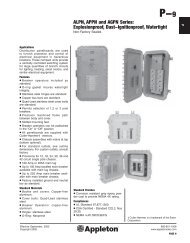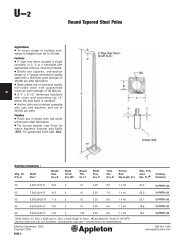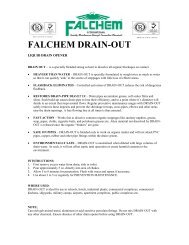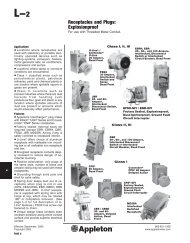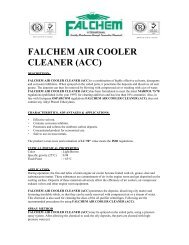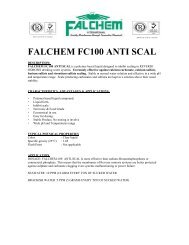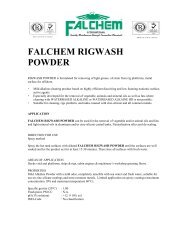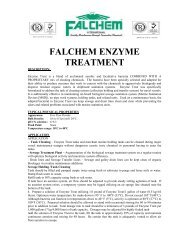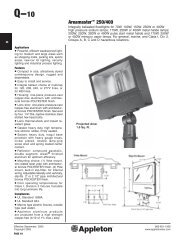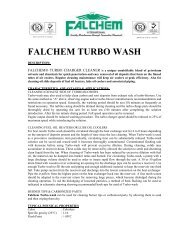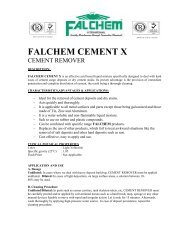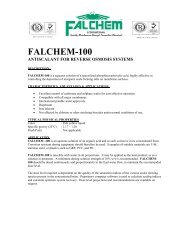Untitled
Untitled
Untitled
Create successful ePaper yourself
Turn your PDF publications into a flip-book with our unique Google optimized e-Paper software.
7.06 Technical Information<br />
Class 0<br />
The use of glazed tiles of this class for floor coverings is not<br />
recommended.<br />
Class 1<br />
Floor coverings in areas mainly walked on in soft footwear or<br />
barefoot and not exposed to abrasive dirt (e.g. bathrooms and<br />
bedrooms without direct access from outside).<br />
Class 2<br />
Floor coverings in areas occasionally walked on with soft or normal<br />
footwear and exposed to only little abrasive dirt (e.g. rooms in living<br />
areas of houses, except kitchens, entrances and similar heavily<br />
frequented rooms). This does not apply to special footwear such as<br />
e.g. hobnailed boots.<br />
Class 3<br />
Floor coverings in areas frequently walked on with normal shoes<br />
and exposed to little abrasive dirt (e.g. kitchen-cum-living-rooms,<br />
halls, corridors, balconies, loggias and terraces). This does not<br />
apply to special footwear such as e.g. hobnailed boots.<br />
Class 4<br />
Floor coverings walked on regularly and exposed to little abrasive<br />
dirt, so that they are subject to greater stress as in the case of class<br />
3 (e.g. commercial kitchens, hotels, exhibition and sales rooms).<br />
Class 5<br />
Floor coverings subject to heavy pedestrian traffic over long periods<br />
of time and exposed to little abrasive dirt, so that they are subject<br />
to the most extreme stress under which glazed tiles can be applicable<br />
(e.g. public areas such as shopping centres, entrance halls of<br />
airports, hotel foyers, public footpaths and industrial applications).<br />
Every floor covering is subject to wear. This depends on the area of<br />
application and the frequency of use, the kind and degree of dirt<br />
as well as the hardness and resistance to wear of the covering material.<br />
While unglazed vitrified floor tiles can be used practically<br />
anywhere, glazed floor tiles have to be categorized according to<br />
stress groups. Scrapers, mats and the like help to remove dirt and<br />
abrasives and to protect glazed floor coverings. Something of this<br />
kind has to be provided especially in rooms with direct access from<br />
outside or from the garden.<br />
Extreme Stress<br />
For such areas we recommend the use of integrally coloured,<br />
unglazed tiles, which are available in a wide range of colours and<br />
sizes. Examples: floors subject to high traffic loads, e.g. in supermarkets,<br />
hotels, schools, administrative buildings, railway stations,<br />
hospitals, passageways, etc., taking into account the mechanical<br />
load.<br />
10. Resistance to Glaze Cracking, DIN EN ISO 10545-11<br />
This test takes place in the autoclave at 500 KPa with subsequent<br />
colour control.<br />
Glazes with hair cracks/crazes are marked as such and require the<br />
wetting of the covering prior to pointing to avoid deposits of fine<br />
particles of the pointing mortar in the hair cracks. Coloured pointing<br />
compounds are not suitable in the case of these glazes. The<br />
glaze surfaces must not be marked with felt-tip pen and the like.<br />
11. Thermal Conductivity etc.<br />
Thermal conductivity, heat radiation and storage capacity as well<br />
as the thermal resistance are not standardized. Vitrified material<br />
produces the following approximate values:<br />
Thermal conductivity: 1 W/mK Heat storage capacity: 0.8 kJ/kgK<br />
Heat radiation: 5.3 W/m 2 K 4 Thermal resistance: 0.01m 2 K/W<br />
These are excellent values compared to other building materials.<br />
12. Electrical Leakage Resistance<br />
With normally > 10 10 Ohm, ceramics is antistatic and insulating in<br />
dry condition. With the series Eladuct and KerAion ELA 10.6 (electrical<br />
leakage resistance ≤ 10 6 Ohm), however, we also offer conductive<br />
ceramic materials.<br />
The derivation ability for electrostatic charges of the floors according<br />
to DIN EN 1081 is measured locally.<br />
13. Steam Diffusion Resistance<br />
According to DIN EN ISO 12572 the steam diffusion resistance is<br />
approx. µ 120,000 in the case of vitrified material/split tiles and<br />
µ 100,000 in the case of earthenware (excluding joints).<br />
14. Resistance to Frost, DIN EN ISO 10545-12<br />
The test for frost resistance is carried out on 10 samples or > 0.25<br />
m 2 samples.<br />
After water saturation under vacuum the samples are checked for<br />
defects after 100 frost-thaw alternations.<br />
The resistance to frost of an outdoor flooring, however, does not<br />
only depend on the quality of the ceramic tiles used. Professional<br />
construction and laying are essential. For this, please refer to our<br />
specifications and the notice of the umbrella organization of the<br />
German building and construction industry “Outdoor Tiled and<br />
Paved Coverings”.<br />
15. Light and Colour Fastness<br />
Both glazed and unglazed ceramics are light- and colour-fast<br />
according to DIN 51094.<br />
Technical Information<br />
7. Coefficient of Expansion, DIN EN ISO 10545-8<br />
The coefficient of expansion is ascertained between room temperature<br />
and 100°C. The measured values are at around 6 x 10 –6 /K in<br />
the case of vitrified materials. At 8 m length and 50° temperature<br />
difference the result is an expansion of 2.4 mm (in the case of<br />
screed/concrete 4.6 mm and steel 5.6 mm).<br />
8. Thermal Shock Resistance, DIN EN ISO 10545-9<br />
The thermal shock resistance is tested between 15° and 145°C.<br />
9. Moisture Expansion, DIN EN ISO 10545-10<br />
The moisture expansion is determined between tempered and<br />
water-saturated samples.<br />
16. Luminance<br />
The lightness value of a tile describes the brightness of the surface<br />
as perceived by the human eye. The measuring value Y = 100 corresponds<br />
to the brightness of an absolutely white surface, and<br />
Y = 0 to that of an absolutely black surface.<br />
The lightness value is determined for mono-coloured tiles.<br />
17. Behaviour in Fire<br />
Ceramic tiles are classified A 1 according to DIN 4102. Therefore,<br />
they are generally non-combustible and thus fire-resistant. Also in<br />
the case of fire they do not release any toxic emissions.<br />
Price list 2010, status December 2009



